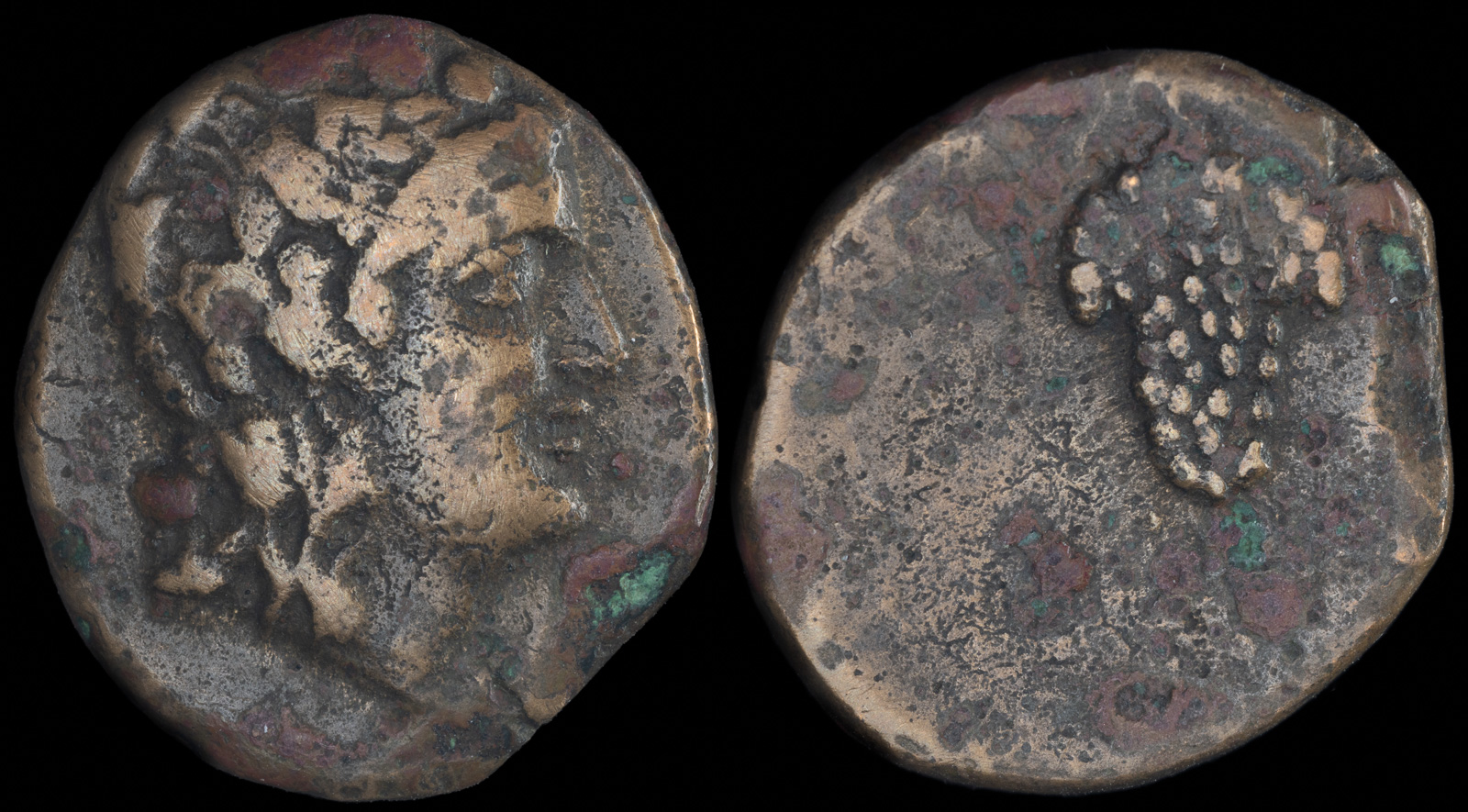
Islands off Ionia, Ikaria/Oinoe
4th century BCE
Æ 19mm, 5.06g
Wreathed head of Dionysos right /
Grape bunch
SNG Copenhagen 1671-2; HGC 6, 1160
The scene was the eastern Aegean. Two fishermen, while on their usual trawl up the coast, witnessed the unbelievable sight of a boy, high in the sky, with his arms flailing as he plummeted to his doom. Above him, a trail of feathers recorded his fall, until he crashed into the waves with such fury that even Poseidon checked his doorcam for the cause of the commotion.
The boy, named Ikaros, was declared deceased on the scene, and camera crews and the FAA were soon at work. Across the Greek world, the crash was the leading topic of gossip.
“Did you hear that King Minas blamed Daedalus for his labyrinth being solved?” they whispered to each other. The family of the Minotaur even publicly blamed Ariadne for the debacle, and she and Theseus promptly responded with a defamation and libel suit that further crowded the tabloids. Yet the sad truth was that Ikaros, the son of Daedalus, was dead, and once the black box was recovered a few days later, it became clear that the crash was due to pilot error, specifically that he’d flown too close to the sun for the specification of glue used to attach the feathers to his bodice.
By that time, the furor around the incident had grown so large that the island which had served in the boy’s last vision renamed itself to Ikaria and began profiting from tours of the area. Of course, such fame can never last, and when the tourists dwindled, they turned to wine production. Their capital city, Oenoe, was named with the Greek word for “wine”.
Oenoe began minting coins in the 4th century BCE, with grapes on the reverse to advertise its wine production. However, as a consequence of the settlement with Ariadne, they had to depict her new husband Dionysos on the obverse. By that time, of course, the populace had an even more scandalous affair that provoked an even greater chatter across the Aegean.
It turned out that the twin princes of the kingdom were not from Queen Theano, who until then had been a woman of unimpeachable fidelity. Some years earlier, when her husband Metapontos had demanded she bear him children or quit the kingdom, she’d taken the twin sons of the dutiful Melanippe to silence him. Shortly after their arrival, so excited was Metapontos that he loaded up on silphium and Theano soon found herself pregnant with her own twins. Oh how the Fates do play!
Theano, aware that her rightful heirs were in reality third and fourth in the succession, devised a plan to kill the false princes in a hunting expedition. Unlucky for Theano’s progeny, Melanippe’s twins had just received a pair of Smith & Wessons, gifts from Poseidon for their birthdays, and thus made quick work of their foes when challenged to battle. Poor Metapontos had no clue of the ordeal until he found Theano hanging from the rafters after she learned of her ignominious defeat.
The entire kingdom was in an uproar, and to ensure there was some legitimacy to the throne, he married Melanippe in the biggest of spectacles. Everyone was there. Helen showed up in a gown of the ages amidst gossip that a son of Priam took improper notice. Kassandra arrived with some dire warnings none of us can remember, while Pandora supplied the party favors.
Many centuries later, the rare coins from this island are feint reminders of these events and festivities. I’m personally glad to have one.
In ancient times, the sea around Ikaria was greatly feared. Homer said:
“And the gathering was stirred like the long sea-waves of the Icarian main”
Horace wrote:
“The merchant afraid of the African winds as
they fight the Icarian waves, loves the peace
and the soil near his town, but quickly rebuilds
his shattered ships, unsuited to poverty.”
Per Athenaios “Eparchides claims that the vine that produces Icarian Pramnian is called ‘sacred’ by people from elsewhere, but ‘Dionysias’ but the inhabitants of Oenoe; Oenoe is a city on the island.”
Settlers from Miletos colonize Ikaria.